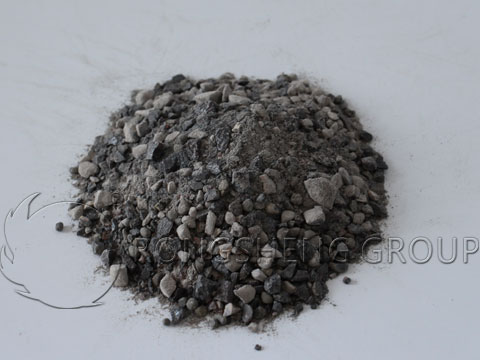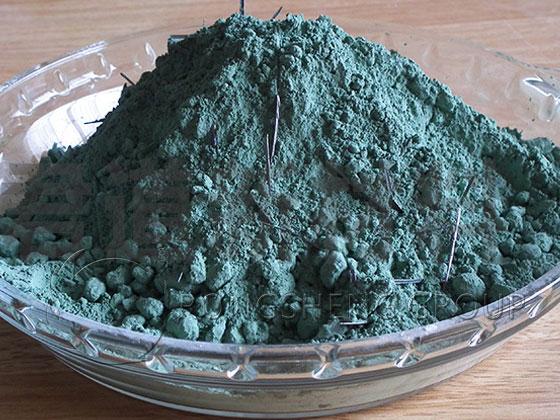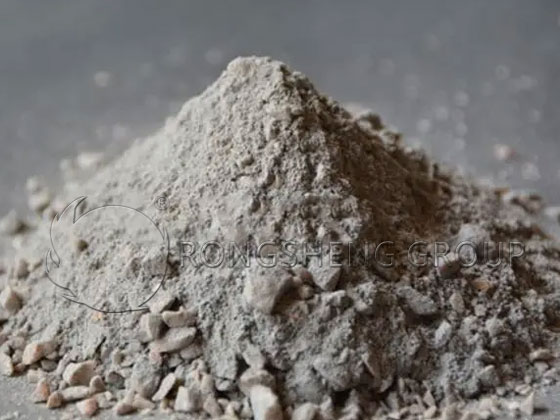Magnesia refractory castable is a castable refractory material with magnesium oxide (MgO) as the main component. According to the material, it can be divided into: alkaline castables such as magnesia, alumina-magnesia, spinel, magnesium-chromium, magnesia-silica and magnesia-carbon. Magnesite (periclase) refractory castables are prepared from fused magnesia or sintered magnesia aggregates and fine powder.

Magnesium Refractory Castables with Different Properties
The magnesia refractory castable combined with high alumina cement has the advantages of high purity, small linear change rate after burning, and high load softening temperature. However, as the heat treatment temperature increases, especially between 400 and 1200°C, the magnesium hydroxide generated by the hydration of magnesia loses its cementing effect due to dehydration, and the combination of refractory aggregate and powder becomes loose and peels off.
The magnesia refractory castable combined with water glass has the advantages of high strength and strong resistance to alkali and sodium salt molten corrosion. However, due to the use of water glass as a binding agent, a large amount of Na2O (or K2O) and SiO2 are brought in, which greatly reduces the fire resistance and load softening temperature of magnesia refractory castables. This limits the maximum service temperature of water glass bonded castables.
The magnesia refractory castable combined with polyphosphate has the advantages of high strength after burning, small decrease in strength as the heat treatment temperature increases, high softening temperature under load, and good thermal shock resistance. However, at high temperatures (above 1400°C), the strength of magnesia castables decreases due to the large amount of P2O3 volatilization. Generally speaking, sodium polyphosphate is used as the binder for magnesium castables.
Commonly used ones include sodium tripolyphosphate, sodium hexametaphosphate, etc. The degree of polymerization of polyphosphate and the content of P2O3 have a great influence on the strength of castables. When the average polymerization degree of polyphosphate is 24, the castable has the greatest strength. In addition, in order to improve the high-temperature strength of magnesia refractory castables, add an appropriate amount of calcium-containing materials (such as calcium carbonate, etc.). In order to generate the Na2O·2CaO·P2O5 phase with high collective strength and stable existence at high temperature.
However, no matter which of the above-mentioned binders is used, it is difficult to overcome the problem of easy hydration of magnesia refractory castables, and cracks are prone to occur during the drying process. Adding an appropriate amount of silica ultrafine powder can overcome hydration problems.

Advantages of Ultrafine Powder Combined Magnesium Refractory Castables
Ultrafine powder combined with magnesium refractory castables were successfully developed around 1990. They have good resistance to slag erosion, less pollution to molten steel and have a purification effect. However, due to the presence of magnesium oxide, the resistance to slag permeability and thermal shock resistance is reduced. At the same time, the low medium temperature strength and easy water absorption and powderization affect the promotion and use of castables.
In recent years, a lot of effective work has been done in the research and improvement of the varieties and performance of ultrafine powder combined with magnesium refractory castables. Its varieties have increased and its defects have been improved. It has also been used in thermal equipment such as ladle slag line, tundish working lining and slag weir, non-ferrous metallurgical Ausmelt furnace and slag depletion furnace, with good results.
The varieties of superfine powder combined with magnesia refractory castables include magnesia, magnesia chromium, magnesia spinel and magnesia calcium. The first three castables developed earlier, faster and more practical, and the latter magnesia calcium refractory castable is under development. The key is to solve problems such as hydration.
The refractory aggregates of superfine powder combined with magnesia refractory castables include fused or high-purity magnesia, high-quality magnesia, brick-making magnesia and metallurgical magnesia. Refractory powders include magnesia powder, chromite powder, aluminum magnesium spinel powder, Cr2O3 and a-Al2O3 and other superfine powders, and uf-SiO2 powder is used as a binder, and admixtures and explosion-proof agents are added.

Magnesia Cement Refractory Castables
Magnesia cement mainly includes periclase cement and periclase-spinel cement, which are made by grinding highly recrystallized sintered magnesia sand. Its setting and hardening mechanism is mainly the hydration reaction of magnesium oxide and the crystallization of magnesium hydroxide. The reaction formula of cement is:
MgO+H2O——Mg(OH)2
However, the hydration rate of periclase cement is slow. Therefore, tempering agents such as magnesium chloride, magnesium sulfate and magnesium nitrate should be added to promote its hydration and crystallization. It is well known that the solubility of magnesium hydroxide in water is very small, and its gel is difficult to crystallize into large particles. When the tempering agent is added, the boiling point of the tempering water is increased, the solubility of magnesium hydroxide is increased, and the crystallization and growth of magnesium hydroxide gel are accelerated. This needle-shaped brucite crystal cross-grows, which makes the magnesia cement refractory castable gain strength. The effect of magnesium chloride as a blending agent is better than that of magnesium sulfate and other blending agents because magnesium chloride as a blending agent also generates magnesium oxychloride which gradually crystallizes and promotes the coagulation and hardening of cement.
This type of refractory castable is air-hardening and should be naturally cured after molding without watering.
For example, the mix ratio of refractory castables combined with magnesia cement is that the refractory aggregate is metallurgical magnesia sand aggregate, chromium slag and cement, iron powder, and magnesium chloride solution and magnesium sulfate solution are added with iron powder to act as mineralizers or sintering agents.
The drying strength of periclase cement refractory castable is relatively high. However. At about 400℃, the strength begins to decrease due to the decomposition of magnesium hydroxide. As the heating temperature increases, the organizational structure becomes loose and the strength continues to decrease. When the temperature reaches 1000~1200℃, it has not yet been sintered, and the strength is reduced to the lowest point, only 2.5-9.3MPa. When it exceeds 1200℃, the strength rises slightly due to the recrystallization of magnesium oxide. At about 1400℃, solid phase reaction begins, and the strength increases, which is about 25% of the drying strength. When iron powder and chromium slag are added, the sintering of periclase can be promoted, and the medium-temperature strength is improved.
To purchase high-quality magnesium refractory castables, please choose Rongsheng Refractory Material Factory. The product quality is reliable and the performance is guaranteed.

